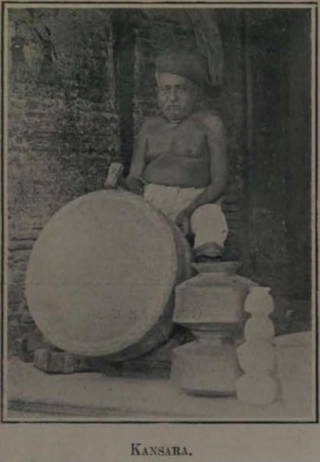
Kolhapur is a city on the banks of the Panchganga River in the southern part of the Indian state of Maharashtra.
Saitwal is a Digambara Jain community of Maharashtra. Swahitwal means that they work for the benefit of their inner self (Swa+hit+wal).
The Jains in India are the last direct representatives of the ancient Shramana tradition. People who practice Jainism, an ancient religion of the Indian subcontinent, are collectively referred to as Jains.

Kumbhoj is the name of an ancient town located in Kolhapur district in Maharashtra. The town is about eight kilometers from Hatkanangale, about twenty seven kilometers from Kolhapur and currently, also is the Taluka or Tehsil Headquarters. The famous Jain Tirtha known as Bahubali, is just two kilometers away from the Kumbhoj city.

Mumbai has one of the largest populations of Jains among all the cities in India. Mumbai also has numerous Jain temples. One of the best known is the Babu Amichand Panalal Adishwarji Jain Temple, Walkeshwar.

Jainism has been present in Maharashtra since ancient times. The famous Ellora Caves demonstrate that Jainism was part of a thriving religious culture in Maharashtra in premodern times.
The Jain Bunt are the Jains of Bunt caste from Tulunaad area of India. It has been said that the Jain Bunts also have the highest per capita income in India. They have a feudal and martial race heritages, because of ties to the erstwhile royalty of the area. They are classified as Other Backward Class (OBC) by the Government of Karnataka.

Mangi-Tungi is a prominent twin-pinnacled peak and Digambar Jain Pilgrimage Site, located near Tahrabad about 125 km from Nashik, Maharashtra, India. Mangi, 4,343 ft (1,324 m) high above sea level, is the western pinnacle and Tungi, 4,366 ft (1,331 m) high, the eastern. Mangi-Tungi is 30 km (19 mi) from the city of Satana.

Karnataka, a state in South India has a long association with Jainism, a religion which enjoyed patronage of major historic kingdoms in the state such as the Rastrakuta Dynasty, Western Ganga, Kadamba and Chalukya dynasties and the Hoysala Empire. Today the state is home to a number of Jain monuments, such as temples, Gommata statues and stambhas.
Narsingpura is one of the Jain communities. It originated from the Mewar (Rajasthan) region. Many of them have migrated to Gujarat, MP, and recently to Maharashtra.

Jainism in North Karnataka flourished under the Chalukyas, Kadamba, Rashtrakutas, and Vijayanagara Empire. Imbued with religious feeling, patronage was extended towards the building of Jain temple and it garnered high repute among the people, particularly the ruling classes and the mercantile community; effectively getting treated as the state religion.
Bhavsar is a caste that originated from warriors. As time passed, the Bhavsar community was made up of weavers, dyers, and printers.

Chhipi is a caste of people with ancestral roots tracing back to India. These people are basically Rajputs and used to wear Kshatriya attire. These people were skilled in the art of war, Later people of this caste started doing printing work. They are found in the states of Gujarat, Rajasthan, Madhya Pradesh, Haryana, Delhi, Uttar Pradesh of India.

The Shantinath Jain Teerth, also known as Shri 1008 Shantinath Digambar Jain Mandir, is a Jain temple located in Indapur, Pune, Maharashtra. The design and architecture of the temple is patterned after that of South Indian temples. The temple is known for its 27-feet tall granite idol of Shri 1008 Munisuvrata, the twentieth Tirthankara. The number 1008 is significant in Jainism and is associated with the Tirthankaras. The temple is also locally known as TheGolden Temple because of its golden facade.

Dakshin Bharat Jain Sabha (DBJS), also known as the South Indian Jain Association, is a religious and social service organization of the Jains in India. The organization is headquartered at Kolhapur, Maharashtra, India. The association is credited with being one of the first Jain associations to start reform movements among the Jains in modern India. The organization mainly seeks to represent the interests of the native Jains of Maharashtra, Karnataka and Goa.

Jainism is an Indian religion which is traditionally believed to be propagated by twenty-four spiritual teachers known as tirthankara. Broadly, Jainism is divided into two major schools of thought, Digambara and Śvetāmbara. These are further divided into different sub-sects and traditions. While there are differences in practices, the core philosophy and main principles of each sect is the same.
The Dhor Koli is a subcaste of the Koli caste found in the Indian states of Maharashtra, Gujarat, Karnataka and Rajasthan. Dhor Kolis are bamboo cutters by profession.

The Kansara caste is a Hindu caste whose traditional occupation is the making of metal utensils; they inhabit the Indian states of Maharashtra and Gujarat.
The Kaikadi are a community in the Indian states of Maharashtra and Karnataka. Their name is derived from kai and kade, while the community derives its name from kai and kadi. Traditionally, they were nomadic, mainly wandering in the Vidarbha region of the state, but most have now settled down. They speak Kaikadi, a Dravidian language closely related to Tamil with significant Indo-Aryan admixture. They practice the puberty function like other Tamil communities.












